INSTRUCTIONS TO CANDIDATES:
- This paper consists of two sections A and B.
- Answer all questions in Section A and B in the spaces provided.
- All working MUST be clearly shown in the spaces provided.
- Non-programmable silent electronic calculators may be used.
- Candidates should answer the questions in English.
SECTION A: 25 MARKS
Answer all questions in this section
-
- Draw a diagram to represent a scale of a micrometer screw gauge of thimble scale 50 divisions and reading 3.68mm
(2mks) - Determine the actual reading if the micrometer screw gauge above has a zero error of 0.03mm. (1mk)
- Draw a diagram to represent a scale of a micrometer screw gauge of thimble scale 50 divisions and reading 3.68mm
- Figure 1 shows a bimetallic strip made of brass and iron. A marble is placed at end of the bimetallic strip
as shown below:-
State and explain what will be observed when the bimetallic strip is strongly cooled
(2mks) - A bottle containing a smelling gas at the front bench of a classroom is opened. State the reason why the gas is detected throughout the room
(1mk) - Figure 2 shows the level of mercury and water in a beaker.

Explain the difference in the shape of the meniscus
(Imk) - Mercury - in glass barometer shows a height of 70cm. What height would be shown in the barometer at the same place if water of density 1.0 x 103kg/m3 is used. (Density of mercury = 13600kgm3) (2mks)
- The figure below shows a beaker containing a block of ice.

State and explain the change in stability when the ice melts.
(2mks) - Figure 3 shows a uniform rod AB which is 40cm long. It has a mass of 2kg and pivoted at C. If 2N is
acting at point B, and 30N force is passed through a frictionless pulley.
Find the force X acting at end A.
(3 marks) - Sketch on the axis provided below a velocity - time graph of a motion of a stone thrown vertically upward from the edge of a platform and eventually the stone lands without bouncing on the ground below the platform.
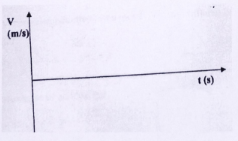
(1 mark) - Figure 4 shows two light sheets of paper arranged as shown.

Explain what is observed if strong air is blown at the same time behind paper Q and in front of paper R as shown
(2mks) - State and explain a branch of physics that involves the study of sound.
(2mks) - State two physical quantities that remain constant while pure ice is being converted to water. (2mks)
- State the reason why thermal conductivity of a metal increases with increase in the cross-section area of the conductor?
(1mk) - State two factors that lower surface tension of water.
(2mks) - On the grid provided, sketch a graph of mechanical advantage against load for a pulley system used to
lift a load.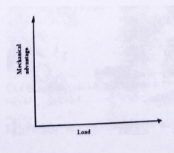
(1 mk)
SECTION B (55 MARKS) (Answer all the questions) -
- State two ways in which the freezing point of ice can be lowered
(2mks) - The figure below illustrates an experiment in which electrical energy is used to determine specific latent heat of fusion.
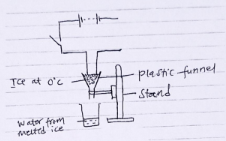
- Complete the circuit to show the essential circuit components.
(2mks) - Write down an equation showing how quantities measured from the above set -up can be used to determine the latent heat of fusion of ice.
(1mk)
- Complete the circuit to show the essential circuit components.
- A block of metal of mass 150g at 100°C is dropped into a lagged calorimeter of heat capacity 40JK-1 containing 100g of water at 25°C. the temperature the resulting mixture is 34°C. (specific heat capacity of water is 4200 JKg-1K-1)
Determine;-- Heat gained by the colorimeter
(2mks) - Heat gained by water
(2mks) - Specific heat capacity of the metal block.
(3mks)
- Heat gained by the colorimeter
- State two ways in which the freezing point of ice can be lowered
-
- One of the factors that affect the centripetal force is the mass of the body. State another factor.
(1mk) - A mass of 400g is rotated by a string at a constant speed V in a vertical circle of radius 100cm. the
tension in the string experienced at point T is 9.2N.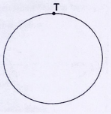
- Determine the velocity V of the mass at point T.
(3mks) - Determine the tension in the string at the bottom of the circle.
(2mks)
- Determine the velocity V of the mass at point T.
- State two applications of circular motion.
- One of the factors that affect the centripetal force is the mass of the body. State another factor.
-
- State the Archimedes principle.
- A rubber envelope of a hydrogen filled balloon having volume of 2m3 is held in position by a vertical
string as shown below.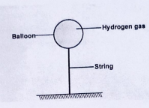
The mass of the balloon is 1.3kg. Given that density of hydrogen is 0.1kg/m3 and density of air is 1.3kg/m3.
Calculate- The total weight of the balloon including the hydrogen gas.
(2mks) - The up thrust.
(2mks) - The tension in the string
(2mks)
- The total weight of the balloon including the hydrogen gas.
- A solid weighs 50N in air and 44N when complete immersed in water. Calculate
- Relative density of the solid.
(2mks) - Density of the solid.
(Imk)
- Relative density of the solid.
-
- Define velocity ratio as used in machines.
(1mk) - The figure below shows a pulley system used to lift a load of 1200N using an effort of 400N
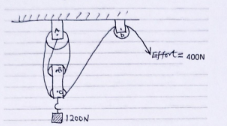
- State the velocity ratio of the system
(1mk) - State the function of pulley D.
(1mk) - Indicate the direction of tension force in each string.
(1mk)
- State the velocity ratio of the system
- The figure below shows an inclined plane. A trolley of mass 30kg is pulled up a slope by a force of 100N parallel to the slope. The trolley moves so that the centre of mass C travels from points A to B.

- What is the work done on the trolley against the gravitational force in moving from A to B?
(2mks). - Determine the work done by the force in moving the trolley from A to B.
(2mks) - Determine the efficiency of the system.
(3mks) - Determine the mechanical advantage of the system.
(2mks)
- What is the work done on the trolley against the gravitational force in moving from A to B?
- Define velocity ratio as used in machines.
-
- What is meant by absolute zero temperature?
- The set up below was used by a group of form three students to verify pressure law.
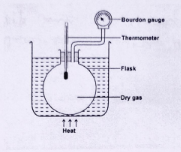
Describe briefly how the set-up can be used to verify pressure law.
(1mk)
(4mks) - A 4.5cm3 bubble released at the bottom of a dam measured 18cm3 at the surface of the dam. Work out the depth of the dam taking atmospheric pressure to be 1 x 105 Pa and the density of water as 1g/cm3
(3mks) -
- What is meant by the term "ideal gas".
(1 mk) - A container holds 70cm3 of air. The pressure is 100kPa and the temperature is 7°C. What is the final pressure when the air is compressed to 30cm3 and the temperature is 27°C. (3 mks)
- What is meant by the term "ideal gas".
MARKING SCHEME
SECTION A (25 MARKS)
-

- 3.68-0.03
= 3.65mm
- Marble rolls down towards the middle because brass contracts more than iron
- Because of diffusion.
- Adhesive forces between water molecules and glass beaker are stronger than cohesive forces between water molecules hence resultant force makes water to form a concave meniscus. Cohesive forces between mercury molecules are greater than adhesive forces between mercury molecules and glass beaker hence resultant force makes mercury form a convex meniscus.
- 0.7 x 13600 x 10 = h x 1000 x 10
h = 9.52m - It becomes more stable because the position of centre of gravity is lowered.
- For a system in equilibrium; Moment = Fd
Sum of clockwise moments = sum of anticlockwise moments.
(30x02) + (2x0.1) = (20x0.1) + (x x 03)
6.2-2=0.3x
X = 14N 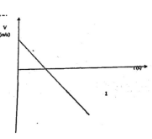
- The papers bulge outwards away from each other. This is due to the pressure outside reducing below atmospheric pressure hence resultant outward force.
- Waves - The study of propagation of energy through space.
(2mks) -
- Temperature
- Mass
- Increase in cross-section area increases the number of free electrons per unit length which are
responsible for thermal conductivity. -
- increase in temperature
- addition of impurities

-
-
- Adding impurities
- decreasing pressure
-

- Vit = mLf
-
- θ = C θ
= 40 x (34-25)
= 360J - Q = mcθ
= 100 x10-3 x 4200 x (34-25)
= 3780J - Heat lost = Heat gained
Heat lost 360 + 3780 = 4140J
MCθ = 4140
C = 4140
150 x 10-3 x (100-34)
= 418.18J/kgK
- θ = C θ
-
-
-
- Radius of the bend
- angular velocity
-
- T = mv2 − mg
r
9.2 = 0.4v2 − 4
1
V2 = 9.2 + 4
0.4
V = 5.745m/s - T = mv2 + mg
- r
= 0.4 x 5.7452 + 4 = 17.2N
1
- r
- T = mv2 − mg
-
- Merry go round
- Speed governors
- centrifuge
- satellites
-
-
- When a body is partially or totally immersed in a fluid, it experiences an up thrust equal to the weight of the fluid displaced.
-
- W = mg + Pvg
= (1.3 x 10) + (2x0.1x10)
= 15N - U = weight of the fluid displaced
U = vpg
U = 2 x 1.3 x 10
U=26N - T=U - W
= 26 - 15
9N
- W = mg + Pvg
-
- RD weight of solid
upthrust
= 50
(50-44)
= 8.333 - Density R.d x density of water
= 8.333 x 1
= 8.333g/cm3
- RD weight of solid
-
- ratio of the distance moved by the effort to the distance moved by the load.
-
- 4
- To change the direction of the effort.

-
- W = F x d
- = 300 x 10
= 3000J - W = F x d
= 100 x 10
Sin 15
= 3863.7J - r = work output x 100%
work input
= 3000 x 100%
3863.7
= 77.65%- M.A.= L
= 300
100
= 3
- M.A.= L
-
- Temperature at which the volume of a gas is assumed to be zero.
- Record the initial temperature and pressure.
- Heat the water bath gently
- record the temperature and corresponding pressure at regular intervals of temperature say 10°C.
- tabulate the results for pressure and absolute temperature.
- draw a graph of pressure against absolute temperature
- the graph is a straight line through the origin with a positive gradient.
This shows that the pressure is directly proportional to absolute temperature.
- P1V1 = P2V2
(105+ h x 1000 x10) 4.5 x 10-6 = 105 x 18 x 10-6
h = 30m -
- An ideal gas is the gas that obeys all the gas laws completely.
- P1V1 = P2V2
Ti T2
100 X 70 = P2 X 30
280 300
P2 = 250kPa
Download Physics Paper 1 Questions and Answers - Catholic Diocese of Kakamega Mock Exams 2023.
Tap Here to Download for 50/-
Get on WhatsApp for 50/-
Why download?
- ✔ To read offline at any time.
- ✔ To Print at your convenience
- ✔ Share Easily with Friends / Students
